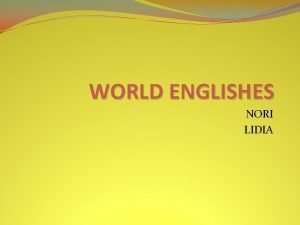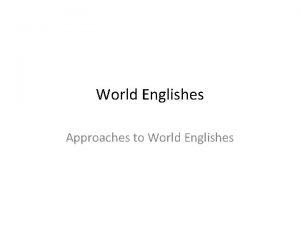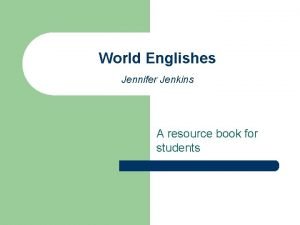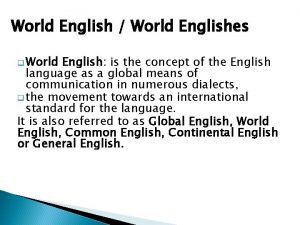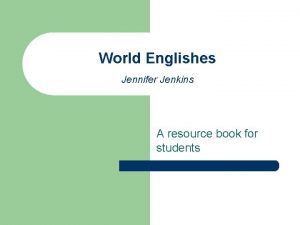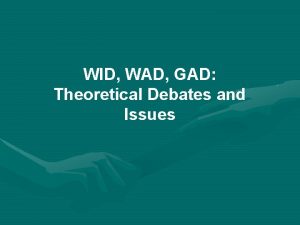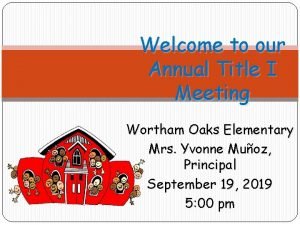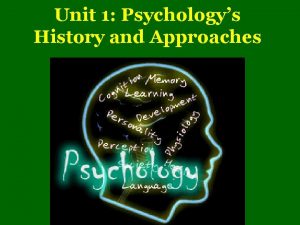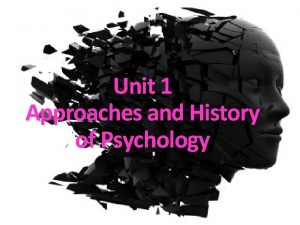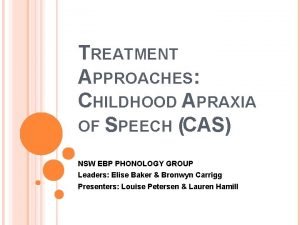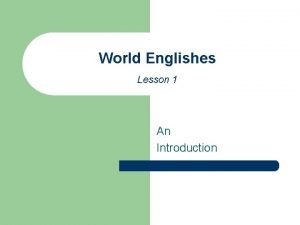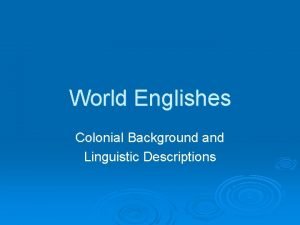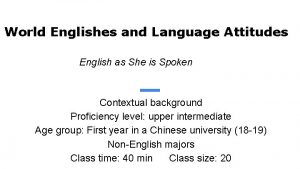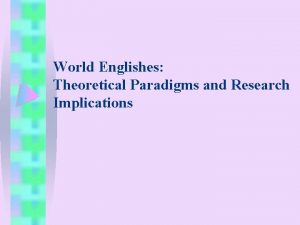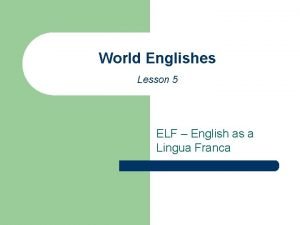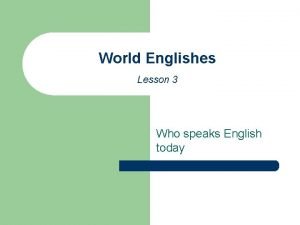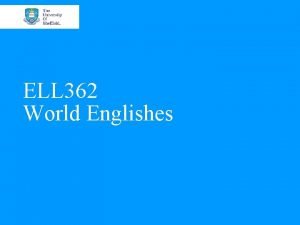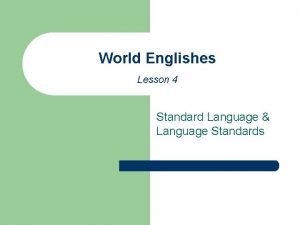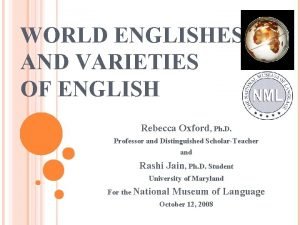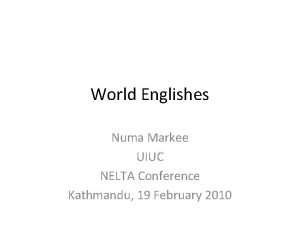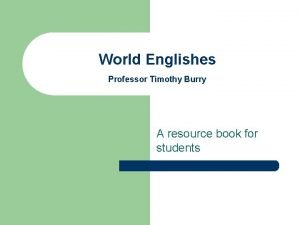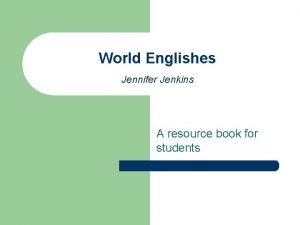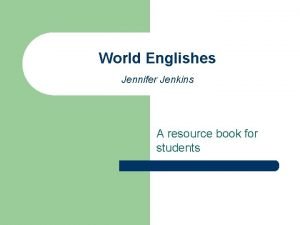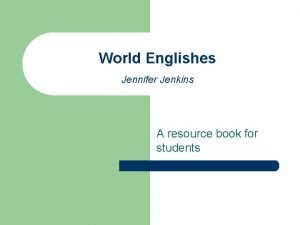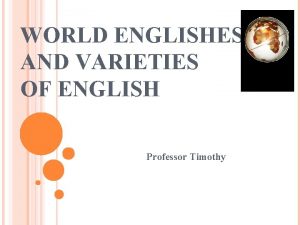World Englishes Approaches to World Englishes Introduction The



















































- Slides: 51

World Englishes Approaches to World Englishes

Introduction • The expression “world Englishes” is capable of a range of meanings and interpretations. • In the first sense, perhaps, the term functions to refer to a wide range of differing approaches to the description and analysis of English(es) worldwide. • Some scholars, for example, favor a discussion of “world English” in the singular, and also employ terms such as “global English” and “international English, ” while others adopt the same terms in their plural forms.

• Indeed, in recent years, a plethora of terminology has come into use, including: English as • an international (auxiliary) language, • global English(es), • international English(es), • localized varieties of English, • new varieties of English, • non-native varieties of English, • second language varieties of English, • world English(es), • new Englishes, alongside such more traditional terms as ESL and EFL.

• In a second narrower sense, the term is used to specifically refer to the “new Englishes” found in the Caribbean and in West African and East African societies such as Nigeria and Kenya, and to such Asian Englishes as Hong Kong English, Indian English, Malaysian English, Singaporean English, and Philippine English.

• In a third sense, world Englishes refers to the wide-ranging approach to the study of the English language worldwide particularly associated with Braj B. Kachru and other scholars working in a “world Englishes paradigm. ”

• When Kachru and Smith took over the editorship of the journal World Language English in 1985, it was retitled to World Englishes, and Kachru and Smith’s explanation for this was that World Englishes embodies “a new idea, a new credo, ” for which the plural “Englishes” was significant:


The English Studies Approach • The “English Studies” approach to world Englishes has developed historically from the description of English tradition, which dates back at least to the late nineteenth century and the work of scholars such as • Henry Bradley (1845– 1923), Otto Jespersen (1860– 1943), Daniel Jones (1881– 1967), Charles Talbut Onions (1873– 1965), Henry Sweet (1845– 1912), and Henry Wyld (1870– 1945). • More recently, this approach may be exemplified by the work of contemporary British linguists, such as Robert Burchfield, David Crystal, Sidney Greenbaum, Tom Mc. Arthur, Randolph Quirk, and John Wells.

• Randolph Quirk was one of the first in the contemporary period to discuss varieties of English and the notion of “standards” of world English in his 1962 book, The Use of English. • His Grammar of Contemporary English (Quirk et al. , 1972) also surveyed varieties of English, although here the aim was to differentiate the “common core” of the language from such classes of variety as “regional, ” “educational, ” “social, ” as well as varieties according to “subject matter, ” “medium, ” “attitude, ” and “interference” (pp. 13– 32).

• Quirk later (1990) assumed the role of a guardian of international “standards” of English and was drawn into a celebrated debate with Braj Kachru on “liberation linguistics, ” but one obvious irony here is that Quirk seems to have begun his academic life as a “linguistic liberal, ” with his 1962 essay arguing for tolerance and noting that:


• Some 20 years on, his 1990 paper was to see him arguing a rather different case, urging overseas teachers of English to keep in constant touch with “native speaker” norms, and praising the merits of a world “Standard English. ”

• In the mid-1980 s, a number of books on world English(es) in the “Engsh studies” tradition were published, including Burchfield’s influential The English Language (1985), Greenbaum’s The English Language Today (1985), and Quirk and Widdowson’s English in the World: Teaching and Learning the Language and Literatures (1985). • Each of these attempted to address issues related to the learning and use of English from a global perspective. • Burchfield (1985) attracted much attention when he discussed the possible fragmentation English along the lines earlier seen with Latin:

• Burchfield’s comparison of the dispersal of Latin in the Middle Ages with English in the 1980 s provides the starting-point for Quirk’s (1985) discussion of “The English language in a global context, ” in which Quirk argues the case for normativity, declaiming at one point that “the fashion of undermining belief in standard English had wrought [=worked/ effected] educational damage in the ENL [English as a native language] countries” and that there is no justification for such an attitude to be “exported” to societies where English has the status of a second or foreign language: • “The relatively narrow range of purposes for which the nonnative needs to use English (even in ESL countries) is arguably well catered for by a single monochrome standard form that looks as good on paper as it sounds in speech” (Quirk, 1985, p. 6).

• By the mid-1980 s, it seems that Quirk had transcended the linguistic radicalism of his youth, and that he was anxious to join battle on behalf of both “Standard English” and “standards” of English. • His 1985 paper also represents a rehearsal for a later engagement against the forces of “liberation linguistics, ” an engagement that would pit Quirk in debate against Kachru some five years later in the pages of English Today.

• Another significant figure in this field since the 1980 s has been Tom Mc. Arthur, the founding and current editor of English Today (from 1985), and the editor of The Oxford Companion to the English Language (1992). Mc. Arthur’s (1987) paper on “The English languages? ” sets out part of his theoretical agenda for the study of world Englishes. • As the title of the article suggests, the notion of plural Englishes is foregrounded in the discussion, and Mc. Arthur asks “If there are by now ‘English literatures’ can the ‘English languages’ be far behind? ” (Mc. Arthur, 1987, p. 9).

• Over the two decades, English Today has had a substantial impact on the discussion and debate about “English languages” around the world with many articles having a geographical focus (Africa, the Americas, Asia, Europe, etc. ), while others have dealt with such issues as corpus linguistics, grammar and usage, history of English, language and gender, and English lexicography worldwide, etc. • Mc. Arthur has also influenced scholarship on world English(es) greatly with his editorship of The Oxford Companion to the English Language (1992), a volume entitled The English Languages (1998), and the recentlypublished Oxford Guide to World English (2002).

• A third influential figure in the 1980 s and 1990 s was Manfred Görlach, whose orientation has been described as “the study of varieties of English in a world-wide context” (Schneider, 1997 a, p. 3). • Görlach’s intellectual lineage was derived of “Anglistik” in the German academic tradition, and he rose to prominence in the field as the founding editor of English World-Wide, which began publication in 1980, and publishes a wide range of articles on dialectology, pidgins and creoles, and the sociolinguistics of English throughout the world.

• Görlach himself has identified his approach as part of “English studies, ” commenting that: “As a sub-discipline of English Studies, a consideration of English as a world language would provide an ideal opportunity to expand the social, historical and geographical aspects of English Studies and. . . might well serve to enhance the appeal of a traditional and somewhat ageing discipline” (Görlach, 1988, pp. 37– 8). • Since Görlach’s retirement as general editor of English World-Wide in 1998, he has been succeeded by Edgar W. Schneider, who has also published widely in this field (e. g. , Schneider, 1997 a, 1997 b).

• Others following similar approaches include Quirk’s former colleagues on the Survey of English Usage, David Crystal and Sidney Greenbaum. • Crystal’s early work centered on academically-oriented English studies (e. g. , Crystal & Quirk, 1964; Crystal, 1969, 1975), but by the mid-1980 s Crystal was moving away from detailed empirical research and embarking on his present career of academic entrepreneur, encyclopedist, broadcaster, and “popularizer” (see section 15. 6 below).

• Greenbaum’s (1985) volume on The English Language Today was an important work at the time, and from 1990 until his death in 1996, Greenbaum also directed the International Corpus of English (ICE) research project, which is being run in around 15 countries worldwide (Greenbaum, 1996; Nelson, Wallis, & Aarts, 2002). • Other British-based scholars include Wells (1982), Burchfield (1985, 1994), Graddol, Leith, and Swann (1996), and Goodman (Goodman & Graddol (1996). • From the United States, further contributions to the study of varieties of English worldwide have also come from John Algeo (1991), Richard W. Bailey (1991), and Frederick Cassidy (1985).

Sociolinguistic Approaches to World Englishes • Sociolinguistic approaches to world English(es) may be regarded as subsuming four types of studies: • (1) the sociology of language (Fishman, Cooper, & Conrad, 1977; Fishman, Conrad, & Robal-Lopez, 1996); • (2) “features-based” approaches to world English(es) (Cheshire, 1991 a; Trudgill & Hannah, 1994, etc. ); • (3) Kachruvian studies (Kachru, 1992, etc. ); and • (4) pidgin and creole studies (Todd, 1984, etc. ).

Applied Linguistic Approaches • One of the first “applied linguistic approaches” to varieties of world English began in the 1960 s with the work of Halliday, Mac. Intosh, and Strevens (1964), • who sought to apply insights derived from “the linguistic sciences” to the newly-emergent field of applied linguistics, • which in Britain and the USA was broadly concerned with theories of language learning, language teaching, and language pedagogy.

• The use of varieties of English around the world, noting that “during the period of colonial rule it seemed totally obvious and immutable that the form of English used by professional people in England was the only conceivable model for use in education overseas” (Halliday, Mac. Intosh, & Strevens, 1964, p. 292). • By the 1960 s, they argued, things were very different, and now there was choice available between American, British, Australian, and other regional variants. Thus, they argue (and this has a very contemporary ring) that:


• The publication of the Halliday, Mc. Intosh, and Strevens (1964) book, and the expression of similar viewpoints in other academic papers, prompted Clifford Prator to publish a spirited yet historically misplaced attack on what he called “The British heresy in TESL” (Prator, 1968). • This paper is of interest because it pre-dates the Kachru– Quirk debate (see above) by some 20 years; and also because of the fact that some of the issues it raises are still discussed today (see Romaine, 1997). heresy 2 a : dissent or deviation from a dominant theory, opinion, or practice

• Prator’s central argument is that “in a country where English is not spoken natively but is widely used as the medium of instruction, to set up the local variety of English as the ultimate model to be imitated by those learning the language” is “unjustifiable intellectually and not conducive to the best possible results” (Prator, 1968, p. 459). conducive: tending to promote or assist <an atmosphere conducive to education>

• He identifies seven fallacies associated with the British heresy: • (1) that second language varieties of English can legitimately be equated with mother tongue varieties; • (2) that second language varieties of English really exist as coherent, homogeneous linguistic systems, describable in the usual way as the speech of an identifiable social group; • (3) that a few minor concessions in the type of English taught in schools would tend to or suffice to stabilize the language; • (4) that one level of a language, its phonology, can be allowed to change without entailing corresponding changes at other levels;

(5) that it would be a simple matter to establish a second language variety of English as an effective instructional model once it had been clearly identified and described; • (6) that students would long be content to study English in a situation in which, as a matter of policy, they were denied access to a native speaker model; and that • (7) granting a second language variety of English official status in a country’s schools would lead to its widespread adoption as a mother tongue. •

• Peter Strevens was one of those singled out for opprobrium by Prator; and it is evidently true that Strevens consistently argued for a varieties-based approach to TESL and TEFL during his academic career (see Strevens 1977, 1980, 1985). • Both his 1977 book New Orientations in the Teaching of English and his 1980 volume Teaching English as an International Language gave substantial coverage to what he glossed as “localized forms of English” (LFEs), arguing that: opprobrium: 1 : something that brings disgrace 2 a : public disgrace or ill fame that follows from conduct considered grossly wrong or vicious b : contempt, reproach


• High heresy indeed, but over the next two decades the influence of such heresy was to change the way that many applied linguists would approach their subject, particularly at the level of theory. • Thus, throughout the 1980 s and 1990 s, issues related to world Englishes began to be communicated regularly to an applied linguistics audience through such publications as The Annual Review of Applied Linguistics, English Language Teaching Journal, TESOL Quarterly, and other journals in the field.

5 The Lexicographical Approach • The domestic English dictionary tradition as exemplified by Samuel Johnson’s (1755) A Dictionary of the English Language and J. A. H. Murray’s Oxford English Dictionary (1884– 1928) embodied two principles: • (1) the potential of dictionaries for “fixing” and standardizing the language (however unrealistic this might turn out to be); and • (2) the identification of a “nucleus” or core of the language, defined according to “Anglicity. ”

• Arguably, the first dictionaries of world Englishes were glossaries produced in the United States at the beginning of the nineteenth century. These included Pickering (1816), Bartlett (1848), etc. • Noah Webster, by contrast, was concerned to produce a national dictionary, for reasons partly if not wholly political, because “As an independent nation, our honor requires us to have a system of our own, in language as well as government. ” • Webster further predicted that: “These causes will produce, in a course of time, a language in North America, as different from the future language of England, as the modern Dutch, Danish and Swedish are from the German, or from one another” (1789, pp. 220– 3).

• His first dictionary appeared early in the nineteenth century (1806), but it was not until 1828 that his major work, An American Dictionary of the English Language, was published. • In the twentieth century, Webster’s was complemented by a number of other works on American English including Craigie and Hulbert (1938– 44), Mathews (1951), and a number of dialect dictionaries including Cassidy (1985). • Earlier dictionaries of Canadian English include Avis (1967), which has recently been superseded by The Canadian Oxford Dictionary (Barber, 1999).

• Australian lexicography can be traced back to Morris (1898), which was intended as a supplement to the OED, and to the list that Lake compiled as a supplement to Webster’s (1898) (cited in Görlach, 1995). • It is only in recent years that Australia has had its own “inclusive” national dictionary, The Macquarie Dictionary (edited by Susan Butler), which was first published in 1981. • In 1988, Oxford University Press published The Australian National Dictionary, subtitled A Dictionary of Australianisms on Historical Principles. • In 1997, the Dictionary of New Zealand English appeared, edited by Orsman (1997).

• South Africa has its own dictionary tradition, starting with Pettman (1913), and continuing to the present with Branford (1987), and Silva’s (1998) A Dictionary of South African English on Historical Principles. • India developed its own tradition of glossaries and wordlists, including Whitworth’s An Anglo-Indian Dictionary (1885) and Yule and Burnell’s Hobson Jobson: A Glossary of Anglo-Indian Words and Phrases ( [1886] 1969). • Later works have included Rao (1954) and Hawkins (1984), but as yet no fully autonomous national dictionary for India or other South Asian societies has appeared.

• In West Africa, there have been plans for a number of years to complete a Dictionary of West African English, but so far this project remains incomplete (Banjo & Young, 1982). • For the Caribbean, there is Cassidy and Le Page’s Dictionary of Jamaican English (1967), and Holm and Schilling’s Dictionary of Bahamian English (1982), as well as the recent Dictionary of Caribbean English Usage (Allsopp, 1996).

• Dictionaries are profoundly important for the recognition of world Englishes. • As Quirk (1990) has pointed out, it is only when a world variety of English is supported by codification (chiefly expressed through national dictionaries) that one can make a strong claim that such a variety is “institutionalized. ” • Perhaps the best example of this in recent times has been the case of Australia where the Macquarie Dictionary has been largely accepted as a “national dictionary” or, in their own words, as “Australia’s own. ”

• By the 1990 s the editors of Macquarie had also become activists for the promotion of world Englishes in Asia, and are now planning a dictionary focusing on English in the Asian region with extensive coverage of the vocabularies of the new Englishes of Southeast Asia, particularly those of Hong Kong, Malaysia, Singapore, and the Philippines. • Susan Butler, Macquarie’s editor, argues that:


Endword: From Theory to Practice • The significance of world Englishes for applied linguistics in the first and wider sense is profound, challenging the discipline to come to terms with a wide range of issues, descriptive and theoretical, linked to the unprecedented impact of English throughout the world. • Current estimates suggest that there are now an estimated 375 million users of English in inner-circle societies, 375 million in outer-circle (ESL) societies, and around 750– 1, 000 million in the expanding (EFL) circle (Mc. Arthur, 2001). Other statistics suggest that in Asia alone the number of English users now totals over 600 million people, including over 300 million in India, and over 200 million in China.

• Virtually every Asian city has an English language newspaper, and many societies in the region also provide English language programs on radio and television. • English is also an important pan-Asian lingua franca in the business world, so that, for example, when a factory manager from Vietnam sells garments to a Singaporean merchandiser, the language of choice is usually English. • The dominant trend over recent decades is that more and more Asian people are speaking more and more English, and they are speaking it mainly to other Asians (Kachru, 1997 b).

• The vast majority of teachers of English as a second and foreign language in the world today are “non-native” teachers working in a wide range of settings in outer-circle and expanding-circle societies. The number of secondary school teachers of English in China alone now totals around 500, 000 (Bolton, 2003). • In outer-circle Asian societies such as Hong Kong, India, Malaysia, Singapore, and the Philippines (as well as a host of African societies), such teachers operate in sociolinguistic contexts where English has established de facto intranational norms, often at variance with the exonormative targets of traditional teaching materials.

• In situations such as these, the maintenance of traditional target norms of English proficiency may not only lack realism but may also contribute to the stigmatization of the norms of local users (including teachers and learners), contributing to a “culture of complaint” rather than “a culture of confidence” (Bolton, 2002 b).

• In addition, the “nativization” of English in many such societies has been accompanied by the “Englishization” of many indigenous languages, leading to complex patterns of contact linguistics, including lexical transfer, codeswitching and code-mixing, and discoursal and syntactic change and accommodation.

• At the same time, despite the greater recognition accorded to the Englishes of Africa and Asia in recent years, considerable problems for applied linguistics still exist in the area of pedagogic principles and practices (applied linguistics in “sense 2” terms). • In many outer-circle societies, questions linked to norms and codification are typically unresolved. • For example, even though some educationalists in societies such as Hong Kong and the Philippines have started to recognize local norms of educated speech, official attitudes frequently remain ambivalent at best.

• A later paper by Kachru and Nelson (1996) goes on to explore the ways in which the world Englishes approach might be adopted within the language classroom, suggesting a number of imaginative strategies that might be employed in teaching Englishes across a variety of educational settings, including l multicultural education, l the teaching of discourse pragmatics, and l the teaching of new literatures in English (see also Kachru, 1997 a).

• Brown (2000) surveys the resources for research and teaching in the field, and suggests a range of research and applied agendas for world Englishes. • At the level of applied linguistics research, these include longitudinal studies of values and attitudes, textual studies in multicultural communities, empirical studies of attitude development and change, and world Englishes-based research on second language acquisition.

• In the last ten years or so, there has been a growing awareness of the world Englishes paradigm among applied linguists and others in outer-circle Englishusing African and Asian societies. • • At an individual level, the English language now plays an important role in the lives of a rapidly increasing proportion of the world’s population. From a global perspective, the sociolinguistically complex sites of English-using African and Asian societies are no mere exotic sideshow, but important sites of contact, negotiation, and linguistic and literary creativity.

Summary • Brief Overview • The English Studies Approaches to World Englishes • The Sociolinguistics Approaches to World Englishes • The Applied Linguistic Approaches to World Englishes • Lexicographical Approach • End words: From theory to Practice
 Lidia urban dictionary
Lidia urban dictionary Peter strevens world map of english
Peter strevens world map of english Jennifer jenkins world englishes
Jennifer jenkins world englishes Definition of world englishes
Definition of world englishes World englishes a resource book for students
World englishes a resource book for students Hát kết hợp bộ gõ cơ thể
Hát kết hợp bộ gõ cơ thể Frameset trong html5
Frameset trong html5 Bổ thể
Bổ thể Tỉ lệ cơ thể trẻ em
Tỉ lệ cơ thể trẻ em Gấu đi như thế nào
Gấu đi như thế nào Tư thế worm breton là gì
Tư thế worm breton là gì Hát lên người ơi
Hát lên người ơi Các môn thể thao bắt đầu bằng tiếng nhảy
Các môn thể thao bắt đầu bằng tiếng nhảy Thế nào là hệ số cao nhất
Thế nào là hệ số cao nhất Các châu lục và đại dương trên thế giới
Các châu lục và đại dương trên thế giới Công thức tiính động năng
Công thức tiính động năng Trời xanh đây là của chúng ta thể thơ
Trời xanh đây là của chúng ta thể thơ Cách giải mật thư tọa độ
Cách giải mật thư tọa độ Phép trừ bù
Phép trừ bù độ dài liên kết
độ dài liên kết Các châu lục và đại dương trên thế giới
Các châu lục và đại dương trên thế giới Thơ thất ngôn tứ tuyệt đường luật
Thơ thất ngôn tứ tuyệt đường luật Quá trình desamine hóa có thể tạo ra
Quá trình desamine hóa có thể tạo ra Một số thể thơ truyền thống
Một số thể thơ truyền thống Cái miệng xinh xinh thế chỉ nói điều hay thôi
Cái miệng xinh xinh thế chỉ nói điều hay thôi Vẽ hình chiếu vuông góc của vật thể sau
Vẽ hình chiếu vuông góc của vật thể sau Thế nào là sự mỏi cơ
Thế nào là sự mỏi cơ đặc điểm cơ thể của người tối cổ
đặc điểm cơ thể của người tối cổ Ví dụ về giọng cùng tên
Ví dụ về giọng cùng tên Vẽ hình chiếu đứng bằng cạnh của vật thể
Vẽ hình chiếu đứng bằng cạnh của vật thể Tia chieu sa te
Tia chieu sa te Thẻ vin
Thẻ vin đại từ thay thế
đại từ thay thế điện thế nghỉ
điện thế nghỉ Tư thế ngồi viết
Tư thế ngồi viết Diễn thế sinh thái là
Diễn thế sinh thái là Các loại đột biến cấu trúc nhiễm sắc thể
Các loại đột biến cấu trúc nhiễm sắc thể Số nguyên tố là
Số nguyên tố là Tư thế ngồi viết
Tư thế ngồi viết Lời thề hippocrates
Lời thề hippocrates Thiếu nhi thế giới liên hoan
Thiếu nhi thế giới liên hoan ưu thế lai là gì
ưu thế lai là gì Sự nuôi và dạy con của hươu
Sự nuôi và dạy con của hươu Sự nuôi và dạy con của hươu
Sự nuôi và dạy con của hươu Sơ đồ cơ thể người
Sơ đồ cơ thể người Từ ngữ thể hiện lòng nhân hậu
Từ ngữ thể hiện lòng nhân hậu Thế nào là mạng điện lắp đặt kiểu nổi
Thế nào là mạng điện lắp đặt kiểu nổi Similarities between wid and wad
Similarities between wid and wad Approaches meets masters
Approaches meets masters Unit 1 psychology's history and approaches
Unit 1 psychology's history and approaches Approaches to psychology
Approaches to psychology Cas treatment approaches
Cas treatment approaches
